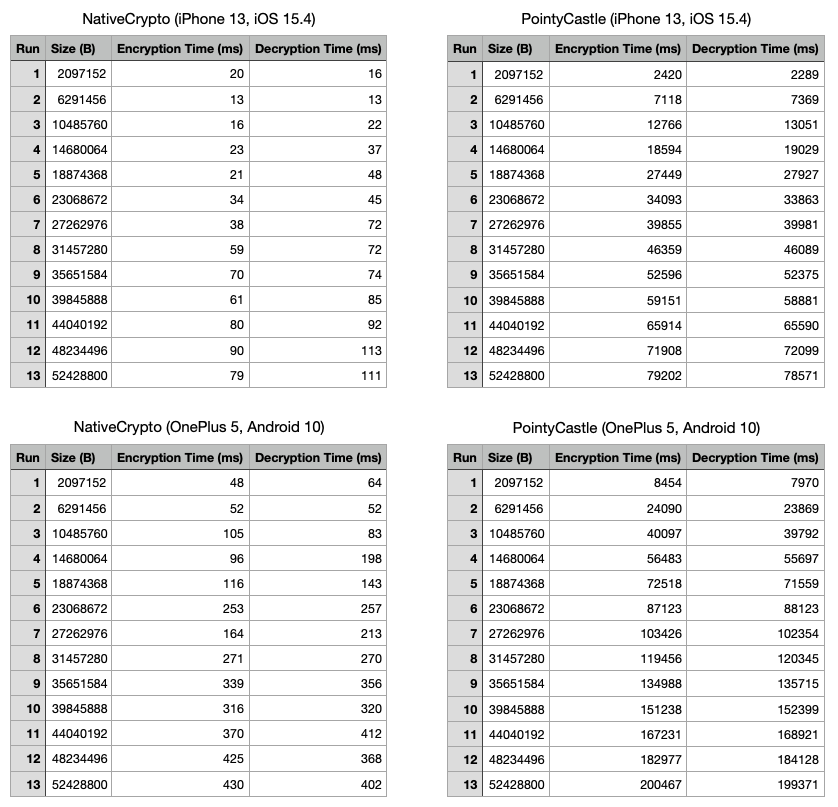/*
- Copyright 2019-2023 Hugo Pointcheval
- Use of this source code is governed by an MIT-style
- license that can be found in the LICENSE file or at
- https://opensource.org/licenses/MIT. */
Fast and powerful cryptographic functions for Flutter.
About
The goal of this plugin is to provide a fast and powerful cryptographic functions by calling native libraries. On Android, it uses javax.cypto, and on iOS, it uses CommonCrypto and CryptoKit
I started this projet because I wanted to add cryptographic functions on a Flutter app. But I faced a problem with the well-known Pointy Castle library: the performance was very poor. Here some benchmarks and comparison:
For comparison, on a iPhone 13, you can encrypt/decrypt a message of 2MiB in ~5.6s with PointyCastle and in ~40ms with NativeCrypto. And on an OnePlus 5, you can encrypt/decrypt a message of 50MiB in ~6min30 with PointyCastle and in less than ~1s with NativeCrypto.
In short, NativeCrypto is incomparable with PointyCastle.
Usage
First, check compatibility with your targets.
| iOS | Android | MacOS | Linux | Windows | Web |
|---|---|---|---|---|---|
| ✅ | ✅ | ❌ | ❌ | ❌ | ❌ |
Hash
To digest a message, you can use the following function:
Uint8List hash = await HashAlgorithm.sha256.digest(message);
In NativeCrypto, you can use the following hash functions: SHA-256, SHA-384, SHA-512
Keys
You can build a SecretKey from a utf8, base64, base16 (hex) strings or raw bytes. You can also generate a SecretKey from secure random.
SecretKey secretKey = SecretKey(Uint8List.fromList([0x73, 0x65, 0x63, 0x72, 0x65, 0x74]));
SecretKey secretKey = SecretKey.fromUtf8('secret');
SecretKey secretKey = SecretKey.fromBase64('c2VjcmV0');
SecretKey secretKey = SecretKey.fromBase16('63657274');
SecretKey secretKey = await SecretKey.fromSecureRandom(256);
Key derivation
You can derive a SecretKey using PBKDF2.
First, you need to initialize a Pbkdf2 object.
Pbkdf2 pbkdf2 = Pbkdf2(
keyBytesCount: 32,
iterations: 1000,
algorithm: HashAlgorithm.sha512,
);
Then, you can derive a SecretKey from a password and salt.
SecretKey secretKey = await pbkdf2.derive(password: password, salt: 'salt');
In NativeCrypto, you can use the following key derivation function: PBKDF2
Cipher
And now, you can use the SecretKey to encrypt/decrypt a message.
First, you need to initialize a Cipher object.
AES cipher = AES(secretKey);
Then, you can encrypt your message.
CipherTextWrapper wrapper = await cipher.encrypt(message);
CipherText cipherText = wrapper.unwrap<CipherText>();
// same as
CipherText cipherText = wrapper.single;
// or
List<CipherText> cipherTexts = wrapper.unwrap<List<CipherText>>();
// same as
List<CipherText> cipherTexts = wrapper.list;
After an encryption you obtain a CipherTextWrapper which contains CipherText or List<CipherText> depending on the message size. It's up to you to know how to unwrap the CipherTextWrapper depending the chunk size you configured.
Uppon receiving encrypted message, you can decrypt it. You have to reconstruct the wrapper before decrypting.
CipherTextWrapper wrapper = CipherTextWrapper.fromBytes(
data,
ivLength: AESMode.gcm.ivLength,
tagLength: AESMode.gcm.tagLength,
);
Then, you can decrypt your message.
Uint8List message = await cipher.decrypt(wrapper);
Development
Android
- Launch Android Studio.
- Select Open an existing Android Studio Project in the Welcome to Android Studio dialog, or select File > Open from the menu, and select the
packages/native_crypto/example/android/build.gradlefile. - In the Gradle Sync dialog, select OK.
- In the Android Gradle Plugin Update dialog, select Don’t remind me again for this project.
iOS
- Launch Xcode.
- Select File > Open, and select the
packages/native_crypto/example/ios/Runner.xcworkspacefile.



